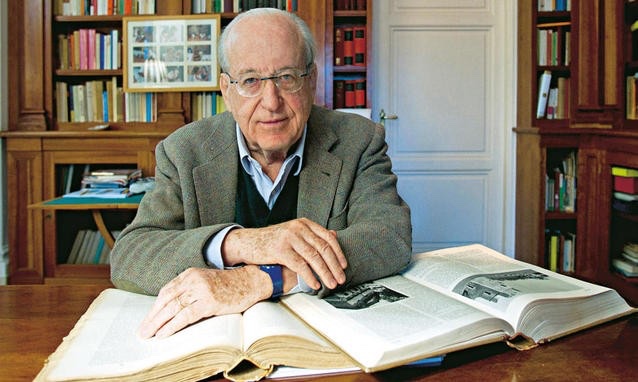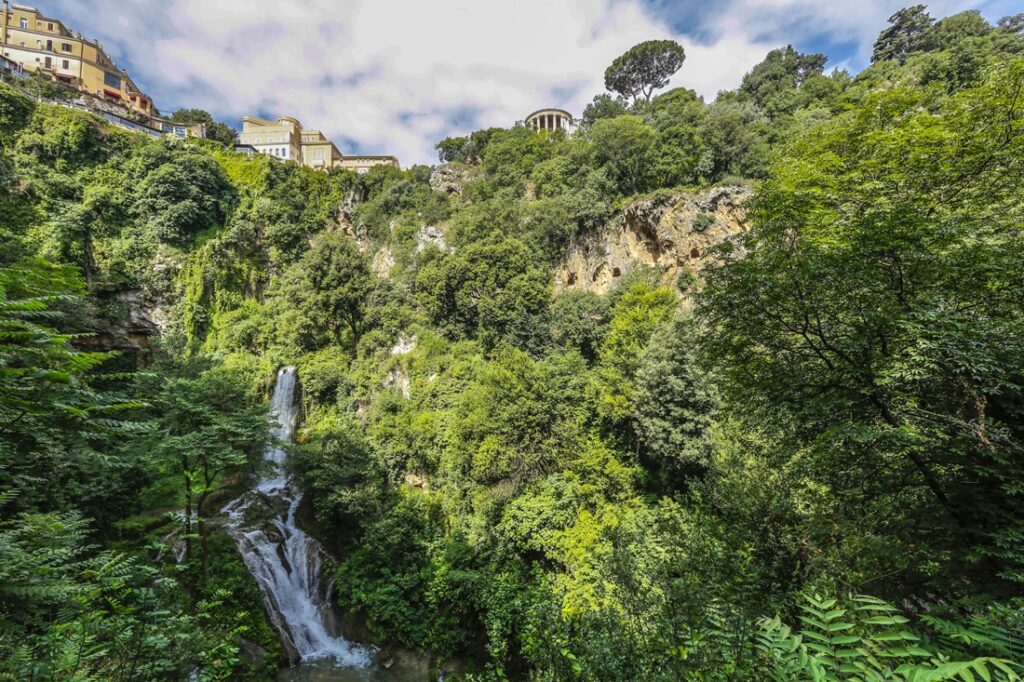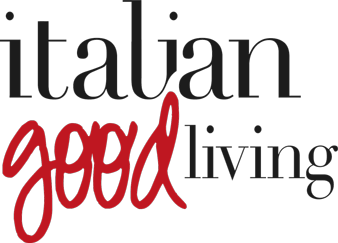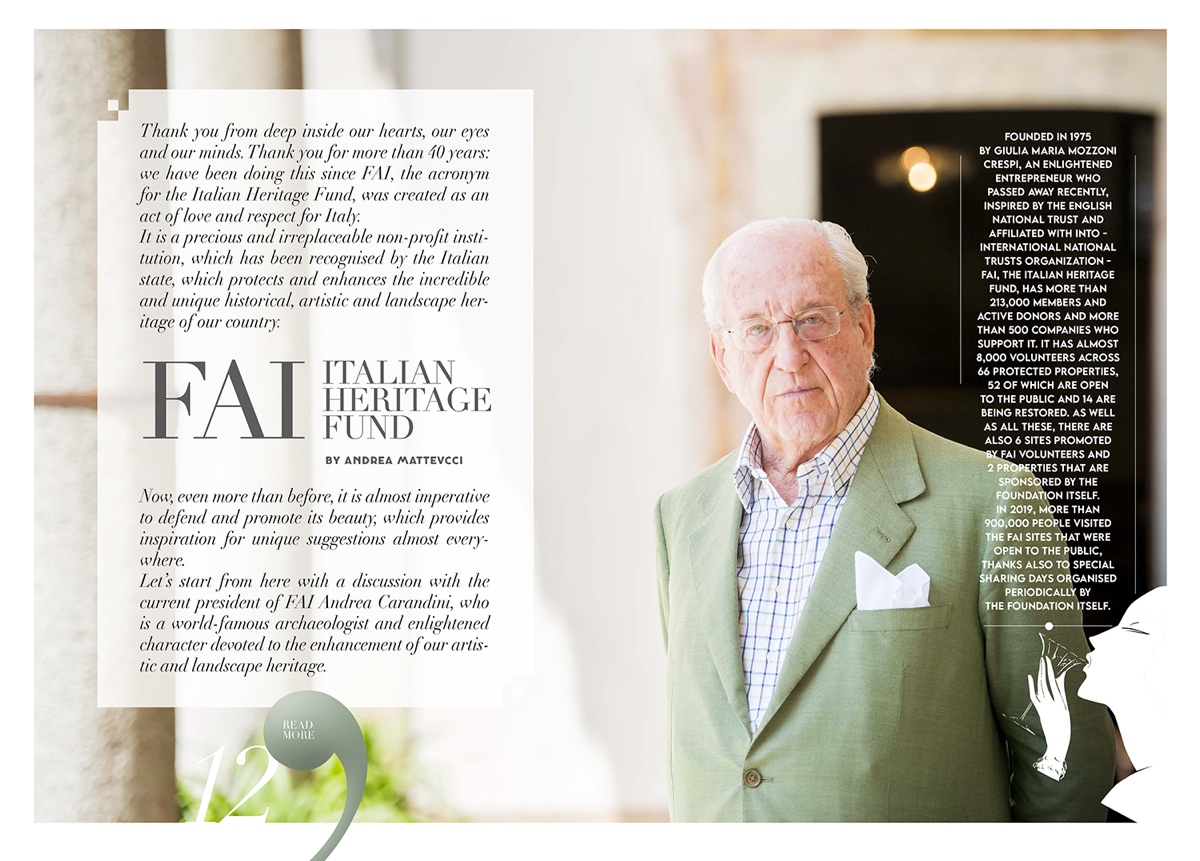FAI, Italian Heritage Fund
Thank you from deep inside our hearts, our eyes and our minds. Thank you for more than 40 years: we have been doing this since FAI, the acronym for the Italian Heritage Fund, was created as an act of love and respect for Italy. It is a precious and irreplaceable non-profit institution, which has been recognised by the Italian state, which protects and enhances the incredible and unique historical, artistic and landscape heritage of our country. Now, even more than before, it is almost imperative to defend and promote its beauty, which provides inspiration for unique suggestions almost everywhere. Let’s start from here with a discussion with the current president of FAI Andrea Carandini, who is a world-famous archaeologist and enlightened character devoted to the enhancement of our artistic and landscape heritage. “For some time now, our country has been suffering and still suffers the phenomenon of tourism that we call hit and run. You observe and visit in a passive way, almost as if it were imperative that you can say and know that you have seen a place, a monument, a city. But in reality nothing remains; it is an unconscious, ephemeral, almost superficial experience. Tourism linked to art and beauty must become an active, conscious and thinking activity: to experience a thing, a place, you need to know its history, customs, in a word, the culture, that embraces it and makes it the way it is”. From a virtuous thought, a possible utopia, to a path that leads to a reversal of the trend, towards a more attentive, complete and active tourism, ideas and strategies are needed: “FAI’s principles have 3 key points for a more intelligent use of our heritage: the first concerns the restoration, conservation and maintenance of artistic assets; the second concerns economic sustainability, given that FAI is similar to a medium-sized company and, as such, must look at its balance sheet and the feasibility of its investments; the third and last point, perhaps the most important at the moment, looks instead at the promotion and enhancement of its sites”. A development model requires careful and virtuous partnerships, with common objectives, a network of communication and continuous exchanges for constant and constructive dialogue with the institutions: “we look to France, with its network made up of the Ministry of Cultural Heritage and several small local private foundations, which are similar to FAI, which in this country are recognised by the state. It is a shared synergistic path that leads to strategies and results of great value”. A French model for our present institutions that are certainly not static and centralist: it is therefore obvious to ask how things work in Italy: “relationships between the state and FAI are excellent; the initiatives are sponsored and shared. There are funds, disbursed by the Ministry and the regions, which allow long-term interventions and planning. It is an exchange that is vertical and horizontal, but also positive, even if there is room for improvement”. A quote from the famous actor Vittorio Gassman comes to mind, a reference that becomes the last question: is there “a great future behind” the FAI? “We have several operational plans that look to the future, which are mainly aimed at improving the hospitality linked to FAI’s assets, at increasing their services and accessibility and, last but not least, at bringing the outer areas closer to the heart of the art cities because, to quote the star architect Renzo Piano, the peripheries need to be repaired”.

Founded in 1975 by Giulia Maria Mozzoni Crespi, an enlightened entrepreneur who passed away recently, inspired by the English National Trust and affiliated with INTO – International National Trusts Organization – FAI, the Italian Heritage Fund, has more than 213,000 members and active donors and more than 500 companies who support it. It has almost 8,000 volunteers across 66 protected properties, 52 of which are open to the public and 14 are being restored. As well as all these, there are also 6 sites promoted by FAI volunteers and 2 properties that are sponsored by the foundation itself. In 2019, more than 900,000 people visited the FAI sites that were open to the public, thanks also to special sharing days organised periodically by the foundation itself.

Abbey of San Fruttuoso
Incredible architecture for a monastery from the year 1000. The Abbey of San Fruttuoso is a real oasis located in a unique setting, between the land and the woods of the Portofino mountain and the blue sea of Liguria di Levante. A monastery, with its cloister and the tombs of the old and noble Genoese Doria family, the primitive church and the parish church, the archaeological artefacts and the small hamlet, is certainly worth a trip to discover the authentic soul of a place that seems to be at the edge of the world.

Abbey of Santa Maria di Cerrate
Charm, history and fascination with a twin soul. The Abbey of Santa Maria di Cerrate, in the heart of the Apulian Salento, was a place of worship and a historic farmhouse; it is the story of a Byzantine monastery, with its scriptorium and library, which has become a centre of olive production. Dating back to the end of the 11th century, in addition to the church, it included stables, accommodation for peasants, a well, a mill and two underground oil mills and represents a splendid example of Apulian Romanesque architecture embellished with important frescoes.

Villa Gregoriana Park
Woods, paths, ancient vestiges, natural caves, the Aniene river engulfed in the rock and an incredible and spectacular waterfall with a drop of 120 metres: in Tivoli, a short distance from Rome, the park of Villa Gregoriana is a unique setting commissioned in the first half of 1800 by Pope Gregory XVI. It is the aesthetics of the sublime close to the Romanesque culture; here nature, history, archaeology and artifice merge in an ideal way into an almost obligatory destination, the main subject of the pictorial representations of Tivoli.

Villa Necchi Campiglio
An icon of art deco in the heart of Milan, Villa Necchi Campiglio is a residence that is surrounded by a quiet garden and is the guardian of fascinating masterpieces of art. Here the breath of the atmosphere of Milan between the two wars becomes intense: designed in the early 1930s by the famous architect Piero Portaluppi as a private residence, it is marked by large linear and elegant volumes and houses works by artists such as Tiepolo, Canaletto, Sironi, De Chirico, Picasso, Fontana, Modigliani and Matisse, amongst others.

